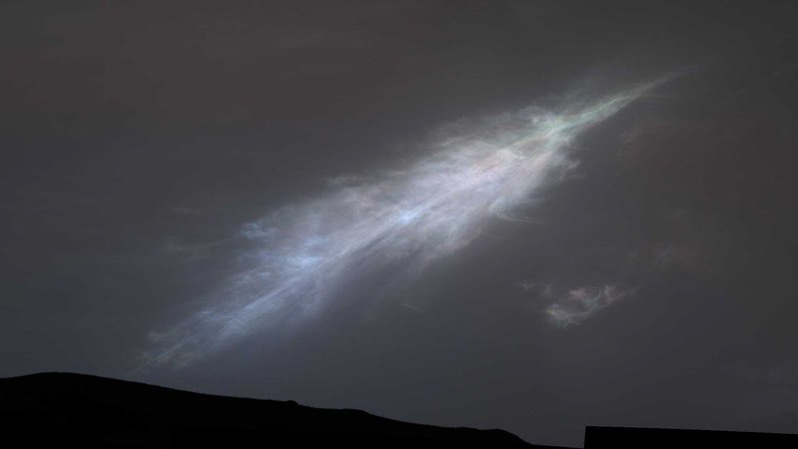
Sunrays on Mars
NASA released the images above and below on March 6, 2023, saying its veteran Curiosity rover has captured our first-ever clear look at sunrays on Mars. It caught the images during a dazzling sunset, and during a new cloud-imaging campaign. NASA said:
Martian sunsets are uniquely moody. But NASA’s Curiosity rover captured one last month that stands out. As the sun descended over the horizon on February 2, rays of light illuminated a bank of clouds. These sunrays are also known as crepuscular rays, from the Latin word for ‘twilight.’
It was the first time sunrays have been so clearly viewed on Mars.

Feather-shaped iridescent clouds on Mars
Now check out the image above. Notice the subtle colors. This feather-shaped cloud is an iridescent cloud on Mars: a cloud that displays rainbow colors. Curiosity captured this image recently, too, on January 27, 2023.
There are many types of rainbow-like clouds on Earth – and probably on Mars, too – including halos and colored arcs. But randomly distributed rainbow colors in a cloud indicate cloud iridescence. Atmospheric scientist Mark Lemmon of the Space Science Institute in Boulder, Colorado explained:
Where we see iridescence, it means a cloud’s particle sizes are identical to their neighbors in each part of the cloud.
By looking at color transitions, we’re seeing particle size changing across the cloud. That tells us about the way the cloud is evolving and how its particles are changing size over time.
NASA said that Curiosity captured both the sun rays and iridescent clouds as panoramas, each of which was stitched together from 28 images sent to Earth.
The images have been processed to emphasize the highlights.
New twilight cloud survey on Mars
In 2021, Curiosity conducted a campaign to observe noctilucent, or night-shining, clouds on Mars. But, since January 2023, the rover has been turning its imaging power to a new twilight cloud survey. NASA explained:
While most Martian clouds hover no more than 37 miles (60 km) above the ground and are composed of water ice, the clouds in the latest images appear to be at a higher altitude, where it’s especially cold. That suggests these clouds are made of carbon dioxide ice, or dry ice.
As on Earth, clouds provide scientists with complex but crucial information for understanding the weather. By looking at when and where clouds form, scientists can learn more about the Martian atmosphere’s composition and temperatures, and the winds within it.
The 2021 cloud survey included more imaging by Curiosity’s black-and-white navigation cameras, providing a detailed look at a cloud’s structure as it moves.
But the recent survey, which began in January and will wrap up in mid-March, relies more often on the rover’s color Mast Camera, or Mastcam, which helps scientists see how cloud particles grow over time.
Meet the robot photographer

Bottom line: NASA’s Curiosity rover has captured our first clear image of crepuscular rays or sunrays on Mars. The rover also caught cloud iridescence on Mars. The images are part of a new twilight cloud survey, being conducted now by Curiosity.
Crepuscular rays: Photos from EarthSky’s community
The post Sunrays on Mars, captured by Curiosity first appeared on EarthSky.
0 Commentaires